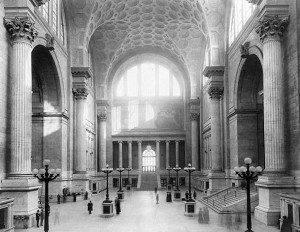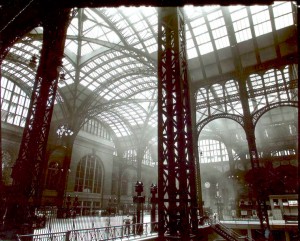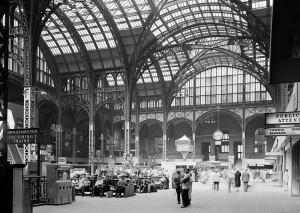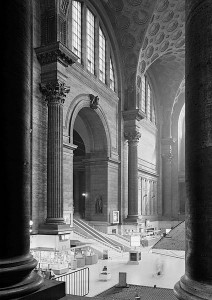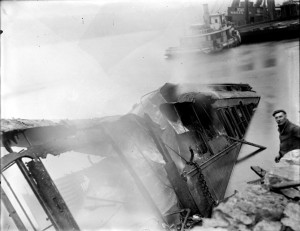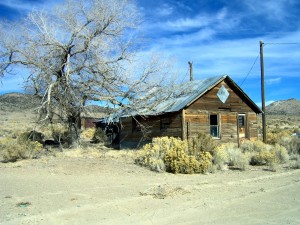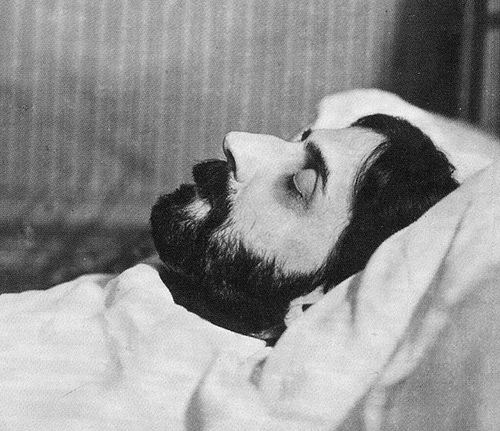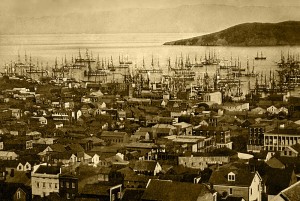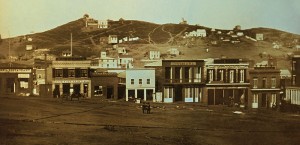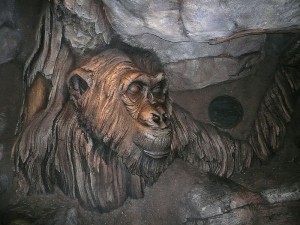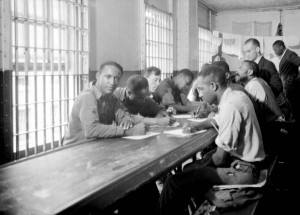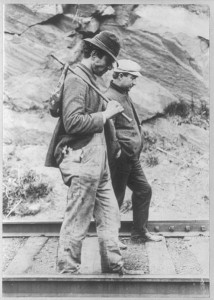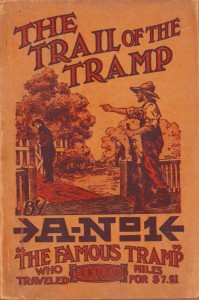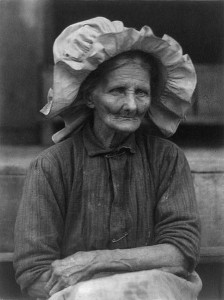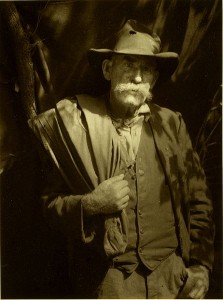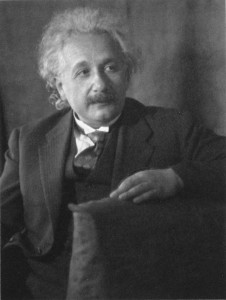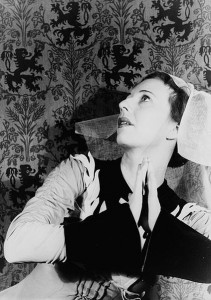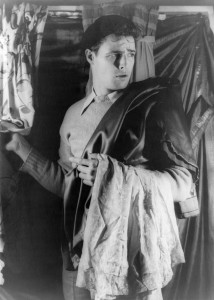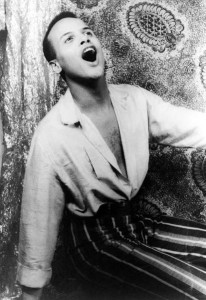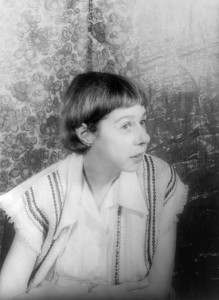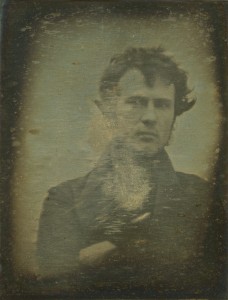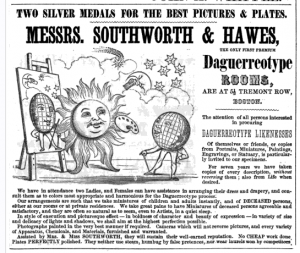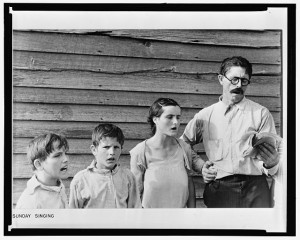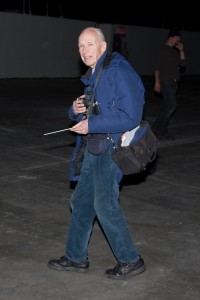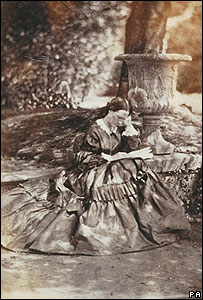This New York Times photo shows a 1919 rent strike in Harlem, in front of Polowinchik’s Fancy Groceries. That was where you bought the good salami.
You are currently browsing the archive for the Photography category.
For some reason, there was a stamp-selling booth shaped like a gigantic mailbox in Times Square in 1961. Just because it was fun, I guess. In this image from the New York World-Telegram & Sun, Assistant Postmaster Aquiline F. Weierich dispenses stamps to actresses Millette Alexander and Louise King, and nightclub entertainer Ted Lewis.
Tags: Aquiline F. Weierich, Louise King, Millette Alexander, Ted Lewis
New York’s original Penn Station, designed by McKim, Mead and White and inspired by Rome’s Baths of Caracalla, was probably the city’s most spectacular building. The rise of air travel during the 1950s left Penn Station underutilized and there was as of yet no Landmarks Preservation Commission to save it from the wrecking ball. Demolition took three years and outcry over the loss of the amazing edifice was global. This set of photos hint at some of its grandeur. Click on images for larger versions.
I hope no train ever goes off a track again, but there can’t be any harm in looking at these spectacular photos of train wrecks from days of yore, which can be found on Wikimedia. Clicking on the images will create larger versions.
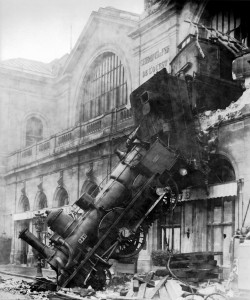
Montparnasse: Brake failure caused a steam train to crash through the station in 1895. (Image by Studio Lévy and Sons.)

Indiana: The Hammond Circus Train Wreck of 1918 occurred due to a conductor falling asleep. There were eighty-six deaths. Fashionably dressed people examine the carnage.
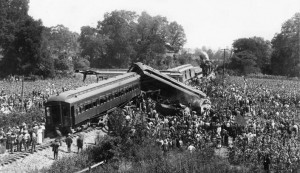
Tennessee: "Nearly A Hundred Killed In A Wreck," read the headlines in Nashville after this 1918 head-on collision. (Image from "The Tennessean.")
lt’s probably difficult to take a bad picture of a ghost town, but these are some especially good ones from Wikimedia that were shot in a variety of abandoned communties in Nevada. Click on images for larger view.

Gold Point: Fifty of the town's buildings still stand, but this one only partially so. (Image by Vivaverdi.)
In A New York Life: Of Friends and Others, Brendan Gill provides a short profile of the artist Man Ray, who was born in Philadelphia in 1890. One of Ray’s most famous photos was of the newly dead writer Marcel Proust. Ray explains to Gill how that photo came about. An excerpt:
“As one of those innumerable visitors to the shrine on the rue Férou, I asked Man Ray about his well-known photograph of Proust’s corpse, the eyes lying sunk into his skull, the chin and cheeks unshaven–never had a body looked more intensely (one might even say, Proust being Proust, more intently) dead–and he told me that it was Cocteau who had arranged for him to take it.
The year was 1922, a short while after Man Ray and Cocteau had met. As Man Ray told the story, surely not for the first time and surely not for the last, his telephone rang one Sunday morning, and it was Cocteau babbling in a high, distressed voice, “Venez toute de suite! Notre petit Marcel est mort!” Man Ray picked up what he called his ‘old shoe’ of a camera and made his way to Proust’s apartment, to which Cocteau admitted him.
The only available light came from a single electric light bulb of low wattage directly above Proust’s bed. Had that made it difficult, I inquired, to take the picture? The little god in his attic looked at me with good-humored scorn. ‘Certainly not!’ he exclaimed. ‘A corpse is the easiest thing in the world to photograph. The subject being motionless. I was able to set my camera for as long an exposure as I pleased. The results were, let me say, satisfactory.'”
Tags: Brendan Gill, Jean Cocteau, Man Ray, Marcel Proust
The California Gold Rush began in earnest in 1848 when James J. Marshall discovered the precious metal at Sutter’s Mill. Most of the hundreds of thousands of wealth seekers who flocked to the state made no real money, which was gobbled up by large gold concerns. Some ancillary wealth was to be had, of course, in setting up businesses to serve the scores of new arrivals. Here are a few archival images of the mad dash. Click on them for larger views.

The steamship "Nicaragua" could take you from New York to California gold regions in 35 days. Also: The fine print promises there will be "200 Jack Asses!" aboard. That's a lot of jackasses.
Tags: James J. Marshall

If Jane Goodall gets one more stuffed monkey as a gift, she will punch you right in the nose. She's nice, but stop.
Any list of the most significant people alive today would be incomplete without Jane Goodall’s name. Trained as a secretary in a time when women weren’t exactly encouraged to study science, she became one of the most significant anthropologists of her time. National Geographic has a celebration of Goodall’s five decades of work studying the Kasakela chimpanzee community in Gombe Stream National Park, Tanzania, putting its entire photographic collection of the scientist and her work online. (Thanks to boing boing for pointing me to the piece.) An excerpt from David Quammen’s excellent accompanying article:
“Science history, with the charm of a fairy-tale legend, records some of the high points and iconic details of that saga. Young Miss Goodall had no scientific credentials when she began, not even an undergraduate degree. She was a bright, motivated secretarial school graduate from England who had always loved animals and dreamed of studying them in Africa. She came from a family of strong women, little money, and absent men. During the early weeks at Gombe she struggled, groping for a methodology, losing time to a fever that was probably malaria, hiking many miles in the forested mountains, and glimpsing few chimpanzees, until an elderly male with grizzled chin whiskers extended to her a tentative, startling gesture of trust. She named the old chimp David Greybeard. Thanks partly to him, she made three observations that rattled the comfortable wisdoms of physical anthropology: meat eating by chimps (who had been presumed vegetarian), tool use by chimps (in the form of plant stems probed into termite mounds), and toolmaking (stripping leaves from stems), supposedly a unique trait of human premeditation. Each of those discoveries further narrowed the perceived gap of intelligence and culture between Homo sapiens and Pan troglodytes.
The toolmaking observation was the most epochal of the three, causing a furor within anthropological circles because “man the toolmaker” held sway as an almost canonical definition of our species. Louis Leakey, thrilled by Jane’s news, wrote to her: “Now we must redefine ‘tool,’ redefine ‘man,’ or accept chimpanzees as humans.” It was a memorable line, marking a very important new stage in thinking about human essence. Another interesting point to remember is that, paradigm shifting or not, all three of those most celebrated discoveries were made by Jane (everyone calls her Jane; there is no sensible way not to call her Jane) within her first four months in the field. She got off to a fast start. But the real measure of her work at Gombe can’t be taken with such a short ruler.”
Tags: David Greybeard, David Quammen', Jane Goodall, Louis Leakey
The following are anonymous photos taken in New Orleans during the 1930s by the Works Progress Administration. They’re not just some sad Depression Era pictures but show people with a lot of hope for the present and future. The WPA’s focus on health, art, construction and education often had that effect.
Hobos aren’t homeless people. Homeless people want a place to live and should be helped. Hobos are drifters by choice who like to roam, who don’t want no home. Below are some historical images of the bindle-stick set.
Tags: Ben Reitman, Leon Ray Livingston
Doris Ulmann, like many great photographers, started out doing other things and rather haphazardly found her calling. Born in New York in 1882 and educated at Columbia University, Ulmann intended to teach psychology. Instead she ended up making portraits of intellectuals and writers and capturing the essence of rural culture in Appalachia, without condescension or romanticization. Below are a few of her images, but you can see more here.
Tags: Doris Ulmann
As dangerous and destructive as extreme weather is, it’s also a wet dream for photographers looking to take amazing photos. Some of the best such recent images have been collected by the great photo site, The Big Picture. Tornadoes, lightning, hailstones and other of nature’s terrors are seen doing their damage all over the world in the online portfolio titled “Stormy Skies.” I don’t have permission to reprint any of them, but go here to have a look.
Iowa native Carl Van Vechten (1880-1964) was a cultural critic, novelist and photographer, who used his trusty 35mm Leica camera to create portraits of an astounding number of artists. Look at a few below and see more here.
Tags: Agnes de Mille, Cab Calloway, Carl Van Vechten, Carson McCullers, Harry Belafonte, Marlon Brando
Thanks to the great Kottke.org for pointing me in the direction of a really fun feature on Oobject, which curates an amazing portfolio of historic firsts from the annals of photography. That includes the initial photo of a human face from 1838 (Robert Cornelius, pictured above, who was chosen for his utter handsomeness) to the first color photograph in 1861 to the first complete image of a molecule in 2009. Have a look at all the cool images.
By the way: Cornelius, a chemist born to Dutch immigrants, worked with fellow scientist Paul Beck Goddard to perfect the daguerreotype. He took the photo of himself outside of his family’s Philadelphia lighting store. It was only in 1975 that evidence emerged that proved the original date of Cornelius’ self-portrait. The picture was off-center but not bad for the first photo of a face ever. Cornelius may have also been a ventriloquist. An excerpt about him from Godey’s Lady’s Book of 1840:
“There is a young gentleman of this city, by the name of Robert Cornelius, one of the firm of the well known house of Cornelius, Son & Co., who has more genius than he yet supposes himself to possess. As a designer in the way of his profession, he has no equal; as a ventriloquist—but here we are getting into private life—as a Daguerreotypist his specimens are the best that have yet been seen in this country, and we speak this with a full knowledge of the specimens shown here by Mr. Gouraud, purporting to be, and no doubt truly, by Daguerre himself. We have seen many specimens by young Cornelius, and we pronounce them unsurpassable—they must be seen to be appreciated.
Catching a shadow is a thing no more to be laughed at. Mr. Cornelius, in one matter, has outstripped the great master of the art, a thing, by the way, peculiar to our countrymen; he has succeeded in etching his designs onto the plate, from which they cannot be removed by any effort. A few more experiments in this way, and we shall do without engravers—those very expensive gentlemen.”
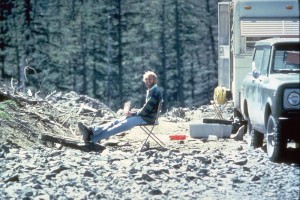
Scientist David Johnston was the Paul Revere of the Mount St. Helens disaster. He was also one of the volcano's 57 victims.
The Big Picture photo site comes through spectacularly again. curating stunning images of the eruption of Mount. St. Helens in Washington in 1980. It was a colossal and shocking natural disaster that began with an earthquake. Soon the volcano erupted and everything was fire, steam, rock, ash, clouds, dust and mud. The explosions lasted for ten hours, razed forests and reached 80,000 feet into the atmosphere. You should definitely look at the entire set of images, “Mount St. Helens, 30 Years Ago.” Even the photos taken just prior to the eruption are chillingly evocative. The caption for the above photo of David Johnston:
“In this May 17, 1980 photo, 30-year old volcanologist David Johnston is shown in the evening at his camp near what is now known as Johnston Ridge near Mount St. Helens. At 8:32 a.m. the next morning, Johnston radioed a message to the USGS headquarters: “Vancouver, Vancouver, this is it!”, shortly before he was killed by the massive eruption of the volcano that also killed 56 others.”
Tags: David Johnston
I recently put up a post about Shanghai World Expo 2010, China’s current World’s Fair, which is the most expensive event in the history of the planet. I just came across some large-scale, eye-popping photos of the Expo on The Big Picture photography site. As usual, that site’s outdone itself with some truly amazing images. I don’t have permission to reprint any of the photos here, but go have a look at the collection and be prepared to be awed. My only commentary is that if Ron Mueck isn’t getting royalties on the gigantic baby sculpture (the first image in the set), he should sue.
More World’s Fair posts:
- Shanghai World Expo 2010.
- Great Exhibition of London in 1851.
- Home movies of NYC’s 1939 World’s Fair.
- Official Guide of NYC’s 1939 World’s Fair.
- Official Guide of NYC’s 1964 World’s Fair.
Tags: Ron Mueck
Before Polaroid and Kodak or even inexpensive tintypes, daguerreotypes were the original popular means of taking pictures. The process, created by French inventor Louis Daguerre with an assist from Joseph Nicéphore Niépce, combined mercury and silver to capture images of the era’s most celebrated politicians, artists and cities.
In 1848, the daguerreotype industry had plenty of competitors and companies had to do whatever they could to get ahead. The Boston, Massachusetts, outfit known as Southworth & Hawes produced a ton of gorgeous images, but that apparently wasn’t enought ot make ends meet. They also advertised themselves as willing to create images of the recently deceased. An excerpt from the ad copy:
“Our arrangements as such that we take miniatures of children and adults instantly, and of DECEASED persons, either at our rooms or at private residences. We take great pains to have Miniatures of deceased persons agreeable and satisfactory and they are often so natural as to seem, even to Artists, in a quiet sleep.”
More Old Print Ads:
- Rubber Party Masks. (1949)
- Slimming Belt for Men. (1952)
- Non-Wilting Jockstraps. (1941)
- Alcohol-Filled Novelty Handgun. (1926)
- Ajeeb, the chess-playing automaton. (Late 1800s)
- Weltmer Insitute of Magnetic Healing. (1898)
- Cataract Electric Washer. (1920)
- Whiz Bang Pep Pills. (1920s)
- Vacutex Blackhead Face Vacuum. (1952)
- P.T. Barnum’s Greatest Show on Earth. (1876)
- Dr. Hopkins’ Electric Hair Restorer. (1868)
- Showgirl Laxatives. (1901)
- Salem Witch Spoon. (1891)
- Panti-Legs. (1961)

The runway at the Saba, Netherlands Antilles' Juancho E. Yrausquin Airport is just 1,300 feet long, surrounded by lots of water.
Why did the people of Thailand build an 18-hole golf course in between the two runways at the Don Mueang International Airport? Why do a thousand flights a year use a beach on the Scottish isle of Barra as an airport when the tide recedes? Why is the Qamdo Banga Airport in Tibet built 14,000 feet above sea level and have an airstrip the length of 61 football fields? In its photo-friendly feature, “The World’s 18 Strangest Airports,” the propeller-heads at Popular Mechanics answer these and other questions. An excerpt from the passage about the teeny Juancho E. Yrausquin Airport in Saba, Netherlands Antilles:
“Background:
Getting to this paradise-like island can be a bit distressing thanks to a 1300-foot-long runway, slightly longer than most aircraft carrier runways.
Why It’s Unique:
Large planes aren’t landing here, but the small runway is difficult even for Cessnas and similar aircraft. ‘The little X means don’t land there,’ says Wayne Schreckengast, a former Navy pilot who is no stranger to landing on less than lengthy runways. ‘It’s challenging, but if you don’t have something like that, the people here don’t get things they routinely need, like mail.’ Given the limited amount of land and rolling topography of the island, not many other options exist.”
I came across this interview that some students conducted with the legendary photographer Walker Evans in 1974. It’s from the archives of Image Magazine.
Evans was a Farm Security Administration photographer who traveled the South during the Great Depression with James Agee; from that experience, they ultimately created Let Us Now Praise Famous Men. During this Q&A, he discussed politics, art, his aesthetic and technology. Evans died just a year after this interview took place.
In one passage, Evans talked about teaching photography, but he might as well be talking about teaching in general. An excerpt:
“Interviewer: What do you tell your students?
Walker Evans: First of all, I tell them that art can’t be taught, but that it can be stimulated and a few barriers can be kicked down by a talented teacher, and an atmosphere can be created which is an opening into artistic action. But the thing itself is such a secret and so unapproachable. And you can’t put talent into anybody. I think you ought to say so right away and then try to do something else. And that’s what a university is for, what it should be–a place for stimulation and an exchange of ideas and a chance to give people the privilege of beginning to take some of the richness of general life that’s in everybody and has to be unlocked.”
Tags: James Agee, Walker Evans

The space suit photo was taken by Fritz Goro, who invented "macrophotography," which made it possible for cameras to capture microscopic images.
“Weird Science in Action” is am essay of 19 cool photos of odd science experiments culled from the amazing Life magazine archives. My favorite one is probably number 14, “Prototype Space Suit, Mojave Desert, California, Early 1960s,” although “Play Ball,” in which a chicken plays a baseball board game (number 15), is also very great.
Number 19 shows a high-voltage demonstration by Jim Vaus, an erstwhile illegal wiretapper and electronics expert who converted to Christianity after hearing a speech by Reverend Billy Graham. Vaus’ story of quitting a crime syndicate and his subsequent religious conversion was the subject of an autobiography and the 1955 film Wiretapper.
See other Great Photography.
Tags: Fritz Goro, Jim Vaus
The great kottke.org pointed me in the direction of a cool-sounding forthcoming documentary by Richard Press called Bill Cunningham New York, which is set to open the New Director/New Films series at MoMA. Cunningham, an octogenarian style/street photographer for the New York Times, still gets around Manhattan on a Schwinn.
An excerpt from Cunningham’s reminiscences about how he ended up being a street photographer who focused on fashion, after having been everything from a waiter to a writer to a milliner to an Army recruit:
“After that, I went to work for The Chicago Tribune, for Eleanor Nangle. She had been there since the 1920’s. A wonderful woman. The best of the best. The Tribune had an office in New York, in the Times building. One night, in about 1966, the illustrator Antonio Lopez took me to dinner in London with a photographer named David Montgomery. I told him I wanted to take some pictures. When David came to New York a few months later, he brought a little camera, an Olympus Pen-D half-frame. It cost about $35. He said, ‘Here, use it like a notebook.’ And that was the real beginning.
I HAD just the most marvelous time with that camera. Everybody I saw I was able to record, and that’s what it’s all about. I realized that you didn’t know anything unless you photographed the shows and the street, to see how people interpreted what designers hoped they would buy. I realized that the street was the missing ingredient.”
Tags: Bill Cunningham, David Montgomery, Eleanor Nangle, Richard Press

The "Tough Guy Challenge 2010" attracted 5,000 male and female entrants. Each one of them is a special kind of crazy.
If you look at this site with any regularity, you probably have an idea how much I love the Big Picture photography site at Boston.com. It’s consistently the best marriage of photography and the Internet. The essay “Tough Guy Challenge 2010” by Mike King is no exception.
The annual excruciating and almost indescribable contest complicated by fire, barbed wire and mud on an English farm is described as “the safest most dangerous taste of physical and mental endurance pain in the world.” I don’t have the rights to repost any of the images here, but I encourage you to go to their site and have a look. It’s worth it.
Tags: Mike King
The Big Picture on Boston.com is the single best photojournalism site on the web. From current events to wry topics, it presents the most amazing shots you can imagine. Think of the photos of Life magazine during it’s glory years and that’s the level we’re talking. One of their current series, “At Work,” spans the globe to show workers in a variety of labors–a brick factory in Pakistan, a chocolate factory in Beijing, a Taiwanese funeral home–in some jaw-dropping images. I don’t have permission to post any of the photos, but go to the site and have a look. You won’t be sorry.
The always wonderful boingboing tipped me off to a group of immaculate photos by Peter Ross of the personal effects left behind by the late, great writer William S. Burroughs. For whatever reason, I always find it interesting to look at the typewriters of authors who lived before the advent of word processing. I wonder if people in the future will look back fondly at the laptops that writers use today. Since most people trade in their computers for new models every few years, it’s unlikely. Back in the day, writers often clung to their hunt-and-peck machines like they were talismans. Also: Is anyone surprised that Burroughs walked around in shoes that had holes in them, possessed an air pistol and blow darts or owned candles shaped like skulls? And of course he had a copy of The Medical Implications of Karate Blows.
Tags: William S. Burroughs
I found this strikingly beautiful 1858 image of nursing pioneer Florence Nightingale (1820-1910) on Listverse.com’s feature, “Top 10 Fascinating Recently Discovered Photographs.” According to the piece, the photo of the camera-shy “Lady with the Lamp” was found in 2006. In the picture, the nurse, writer and staistician is reading outside her family home in Embley Park, Hampshire. The picture, only one of eight known photographs of Nightingale, was taken two years after she returned home from the Crimean War. I wish I had a much larger version of it to share because the photo and not only its subject is great.
Tags: Florence Nightingale




